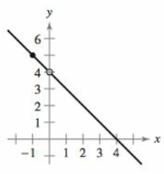P Preparation For Calculus 1 Limits And Their Properties 2 Differentiation 3 Applications Of Differentiation 4 Integration 5 Logarithmic, Exponential, And Other Transcendental Functions 6 Differential Equations 7 Applications Of Integration 8 Integration Techniques, L’hopital’s Rule, And Improper Integrals 9 Infinite Series 10 Conics, Parametric Equations, And Polar Coordinates 11 Vectors And The Geometry Of Space 12 Vector-valued Functions 13 Functions Of Several Variables 14 Multiple Integration 15 Vector Analysis expand_more
1.1 A Preview Of Calculus 1.2 Finding Limits Graphically And Numerically 1.3 Evaluating Limits Analytically 1.4 Continuity And One-sided Limits 1.5 Infinite Limits Chapter Questions expand_more
Problem 1RE: Precalculus or Calculus In Exercises 1 and 2, decide whether the problem can be solved using... Problem 2RE: Precalculus or Calculus In Exercises 1 and 2, decide whether the problem can be solved using... Problem 3RE Problem 4RE: Estimating a Limit Numerically In Exercises 3 and 4, complete the table and use the result to... Problem 5RE: Finding a Limit Graphically In Exercises 5 and 6, use the graph to find the limit (if it exists). If... Problem 6RE Problem 7RE: Using the Definition of a Limit In Exercises 710, find the limit L. Then use the definition to... Problem 8RE Problem 9RE Problem 10RE Problem 11RE: Finding a Limit In Exercises 11-28, find the limit. limx6x2 Problem 12RE: Finding a Limit In Exercises 11-28, Find the limit. limx0(5x3) Problem 13RE Problem 14RE Problem 15RE Problem 16RE Problem 17RE Problem 18RE Problem 19RE Problem 20RE Problem 21RE Problem 22RE Problem 23RE Problem 24RE Problem 25RE: Finding a Limit In Exercises 1128, find the limit. limx01cosxsinx Problem 26RE Problem 27RE Problem 28RE Problem 29RE Problem 30RE Problem 31RE Problem 32RE: Evaluating a Limit In Exercises 29-32, evaluate the limit given limxcf(x)=6 and limxcg(x)=12.... Problem 33RE Problem 34RE: Graphical, Numerical, and Analytic Analysis In Exercises 3336, use a graphing utility to graph the... Problem 35RE Problem 36RE Problem 37RE: Free-Falling Object In Exercises 37 and 38. use the position function s(t)=4.9t2+250 which gives the... Problem 38RE: Free-Falling Object In Exercises 37 and 38, use the position function s(f) = 4.9t2 + 250, which... Problem 39RE Problem 40RE Problem 41RE Problem 42RE: Finding a Limit In Exercises 39-50, find the limit (if it exists). If it does not exist, explain... Problem 43RE: Finding a Limit In Exercises 39-50, find the limit (if it exists). If it does not exist, explain... Problem 44RE Problem 45RE Problem 46RE Problem 47RE Problem 48RE Problem 49RE Problem 50RE Problem 51RE Problem 52RE Problem 53RE Problem 54RE Problem 55RE Problem 56RE Problem 57RE Problem 58RE Problem 59RE Problem 60RE Problem 61RE Problem 62RE Problem 63RE: Using the Intermediate Value Theorem Use the Intermediate Value Theorem to show that f(x)=2x33 has a... Problem 64RE: Delivery Charges The cost of sending an overnight package from New York to Atlanta is $12.80 for the... Problem 65RE Problem 66RE Problem 67RE Problem 68RE Problem 69RE Problem 70RE Problem 71RE Problem 72RE Problem 73RE: Finding a One-Sided Limit In Exercises 79-88, find the one-sided limit (if it exists).... Problem 74RE Problem 75RE Problem 76RE Problem 77RE Problem 78RE Problem 79RE Problem 80RE Problem 81RE Problem 82RE Problem 83RE: Environment A utility company burns coal to generate electricity. The cost C In dollars of removing... Problem 84RE Problem 1PS: Perimeter Let P (x. y) be a point on the parabola y=x2 in the first quadrant. Consider the triangle ... Problem 2PS: Area Let P(x, y) be a point on the parabola y=x2 in the first quadrant. Consider the triangle PAO... Problem 3PS Problem 4PS: Tangent Line Let P (3, 4) be a point on the circle x2+y2=25 (see figure). (a) What is the slope of... Problem 5PS: Tangent Line Let P(5,12) be a point on the circle x2+y2=169 (see figure). (a) What is the slope of... Problem 6PS: Finding Values Find the values of the constants a and b such that limx0a+bx3x=3. Problem 7PS Problem 8PS: Making a Function Continuous Find all values of the constant a such that f is continuous for all... Problem 9PS: Choosing Graphs Consider the graphs of the four functions g1,g2,g3, and g4. For each given condition... Problem 10PS Problem 11PS: Limits and Continuity Sketch the graph of the function f(x)=x+x. (a) Evaluate f(1),f(0),f(12) and... Problem 12PS: Escape Velocity To escape Earth's gravitational field, a rocket must be launched with an initial... Problem 13PS: Pulse Function For positive numbers ab, the pulse function is defined as... Problem 14PS: Proof Let a be a nonzero constant. Prove that if limx0f(x)=L, then limx0f(ax)=L. Show by means of an... format_list_bulleted



 Calculus: Early TranscendentalsCalculusISBN:9781285741550Author:James StewartPublisher:Cengage Learning
Calculus: Early TranscendentalsCalculusISBN:9781285741550Author:James StewartPublisher:Cengage Learning Thomas' Calculus (14th Edition)CalculusISBN:9780134438986Author:Joel R. Hass, Christopher E. Heil, Maurice D. WeirPublisher:PEARSON
Thomas' Calculus (14th Edition)CalculusISBN:9780134438986Author:Joel R. Hass, Christopher E. Heil, Maurice D. WeirPublisher:PEARSON Calculus: Early Transcendentals (3rd Edition)CalculusISBN:9780134763644Author:William L. Briggs, Lyle Cochran, Bernard Gillett, Eric SchulzPublisher:PEARSON
Calculus: Early Transcendentals (3rd Edition)CalculusISBN:9780134763644Author:William L. Briggs, Lyle Cochran, Bernard Gillett, Eric SchulzPublisher:PEARSON Calculus: Early TranscendentalsCalculusISBN:9781319050740Author:Jon Rogawski, Colin Adams, Robert FranzosaPublisher:W. H. Freeman
Calculus: Early TranscendentalsCalculusISBN:9781319050740Author:Jon Rogawski, Colin Adams, Robert FranzosaPublisher:W. H. Freeman
 Calculus: Early Transcendental FunctionsCalculusISBN:9781337552516Author:Ron Larson, Bruce H. EdwardsPublisher:Cengage Learning
Calculus: Early Transcendental FunctionsCalculusISBN:9781337552516Author:Ron Larson, Bruce H. EdwardsPublisher:Cengage Learning




